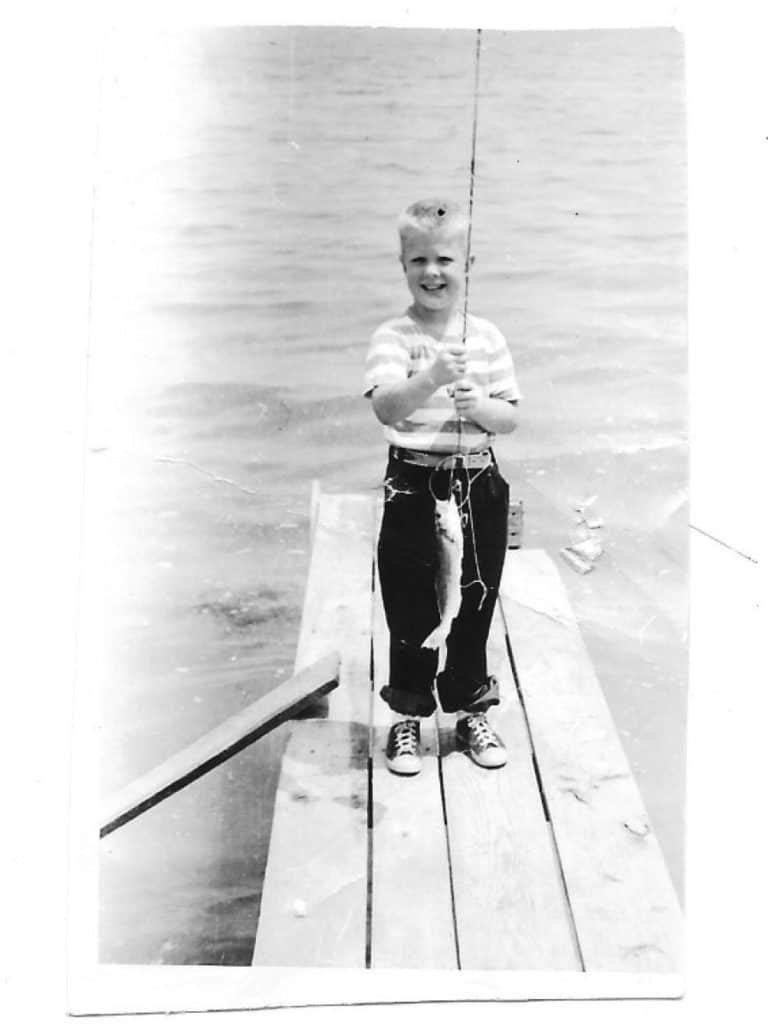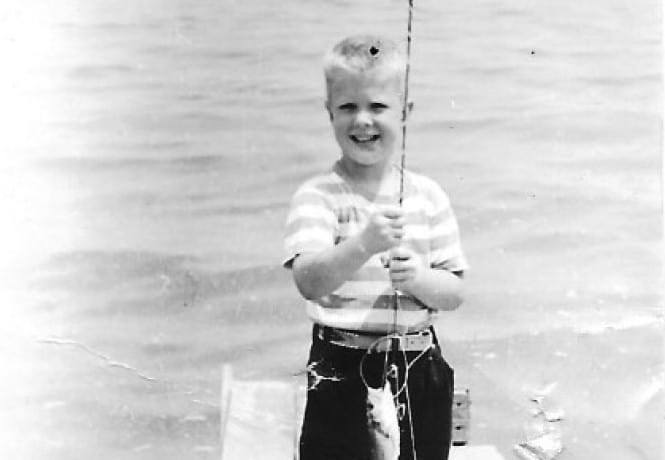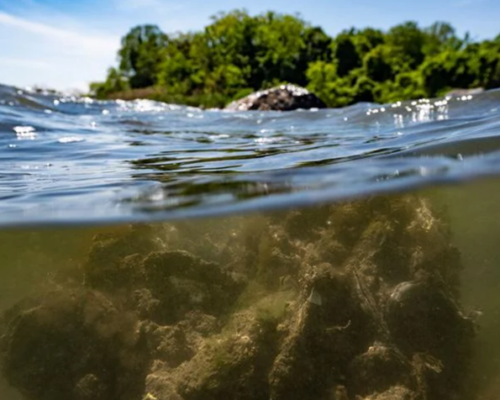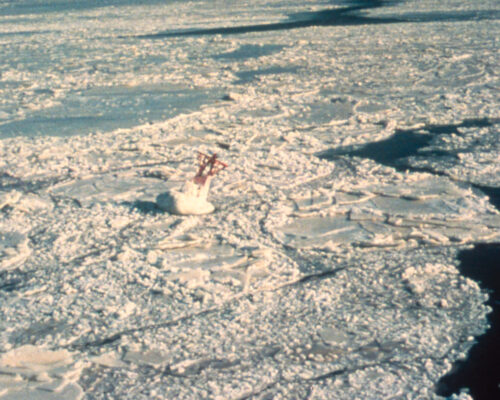Sciaenidae: the Chesapeake’s best-loved family.
My father grew up in a Richmond family that always ate spot for breakfast on Sunday mornings—even in winter when the fish had to be soaked because they had been packed in salt. They dredged them in cornmeal and fried them so the hungry brothers and sisters could pick the succulent meat off the bones.
We happily maintained that tradition at our summer cottage on the lower Potomac when I was a boy. We would clamp our five-horse Johnson outboard onto our 15-foot skiff and chug to the oyster grounds out front to catch them.
Our tackle consisted of cotton handlines wrapped around sticks, rigged with two snelled, #2, Eagle Claw hooks and a two-ounce bank sinker. A bushel basket served as our tackle- and fish-box. Our bait was chunks of peeler crabs that we dipped from our dock pilings. The spot were the primary rewards, but there was always a variety of fish, like big croakers, which pulled so hard on the handlines, and beautiful, yellow-finned, gray trout. I have a photograph my mother took of me, aged about six, proudly holding a trout caught on my first fishing rod.
That family of fish—spot, croakers, trout, and their kin,—represented the basic economy of the Chesapeake then, and they still do, though several members are not nearly as plentiful as they use to be. They form several of the Chesapeake’s most prized recreational and commercial fisheries. Scientists refer to them as Sciaenidae—the drums—a broad and diverse family distributed world-wide. Local members also include red drum, black drum, speckled trout, and the often-scorned-but-actually-tasty silver perch. All have stout internal air bladders, which they use to adjust to pressure changes at different depths. Several species possess specialized muscles that, when contracted forcefully around the bladder, produce a drumming or croaking sound used to communicate with one another.
Most of our sciaenids winter on the Atlantic’s continental shelf. The Bay serves as a warm-weather feeding and nursery ground for them. Some juvenile fish, especially croakers, spend the winter in the Bay, but others, like spot, are moving in now as the Chesapeake warms, riding the deep bottom currents sweeping in through the Virginia Capes. The adults are coming to take advantage of the winter’s growth of critters on oyster reefs and the season’s first soft crabs. All but the two trout species have underslung mouths fitted especially for bottom feeding on marine worms, shrimp, mud crabs, mussels, and clams. Most of them also feed on small fish such as bay anchovies, peanut menhaden, and even their own young. Here’s a rundown:
Spot or Norfolk Spot
These are super panfish, which grow to as long as 14 inches, but are more common in the eight- to 10-inch range. They are excellent quarry for young anglers. Spot are here to eat the Chesapeake’s marine worms. They are true denizens of oyster reefs, and, unlike most of their kin, they show little interest in artificial lures, and they don’t croak. Spot spawn in the Atlantic in late fall and winter with juveniles appearing in the Bay in late spring to feed all summer in shallow waters as far north as the Bay Bridge, where they become prey for rockfish.
Atlantic Croaker or Hardhead
Croakers are larger than spot, and they average 12 to 20 inches as adults. The world record, caught off New Point Comfort Light, went a surprising 27 inches and weighed 8.7 pounds. They are highly vocal when caught and when feeding, especially at dawn and dusk. (There’s a story from World War II that a school of croakers set off lower Bay hydrophone alarms set to detect enemy submarines.) They feed through the summer on reefs, around marsh banks, and in grass beds. Juveniles move into deeper Bay waters for their first winter. Because this species is at the northern edge of its range here, severe winters can kill those juveniles, wiping out whole year classes. Thus, our croaker stock is notoriously variable. We hope the past mild winter has helped them.
Croakers will take flies and jigs. In shallow water, they are powerful fighters. Some anglers refer to them as silver drum. The standard recipe for croakers at the Chesapeake Bay Foundation’s education centers in Tangier Sound is to dip skinned fillets in milk, roll them in panko with Old Bay, and bake them at 450 degrees until they flake—15 to 20 minutes.
Speckled Trout or Spotted Sea Trout

Specks are beautiful, highly soughtafter sport fish that feed heavily on small fish, crabs, and shrimp. They strike flies, jigs, spoons, and plugs, and they put up a hard fight with lots of surface thrashing in their shallow water habitats, especially along marsh edges and grass beds. Like croakers, they are a southern species and susceptible to winter kills, but the population is looking good for 2020. They spawn in the lower Bay and offshore in late spring, and they feed here through summer and fall before mostly moving offshore. A few of them winter in deep lower Bay tributaries where anglers catch them, mostly to tag and release for Virginia’s Saltwater Sport Fish Tagging Program. Young specks spend their first summer in Bay tributaries where they turn up around grass beds at least as far up as Annapolis. Fresh fillets from 14- to 20-inch specks broil beautifully with lemon-butter and fresh-ground black pepper.
Gray Trout or Weakfish
Over one college-year summer, I worked at the Virginia Institute of Marine Science on a pound-net survey team, visiting crews landing fish at wharves in Gloucester and Mathews counties. Retired watermen would walk down to see the catches and trade produce from their vegetable gardens. The range of fish species showing up in those lower-Bay nets was fascinating, but invariably, such a patriarch would choose a nice gray trout to boil with butter beans and tomatoes for lunch. The flavor of larger trout is substantially enhanced by wood-smoke. Close kin to specks, the grays tend to summer in deep water, feeding over shell bottoms in 15 to 50 feet anywhere from the Chesapeake Bay Bridge-Tunnel up past the mouth of the Potomac to Annapolis from May through October, and sometimes later, before moving out to the Atlantic for the winter. Historically we caught them on bottom rigs with bait, especially peelers, and on jigs worked vertically or swum horizontally over shell reefs and stone piles. Gray trout stocks have been low for the past ten years for unknown reasons. We miss ‘em a lot.
Silver Perch or King William
The King William looks like a bleached, white perch with yellow fins, but it is a sciaenid that turns up on lower Bay bottom rigs baited for spot. Maximum size is about nine inches, so most people don’t keep them, but their fillets are as tasty as any of their kin’s. Go ahead and cook the next big one you catch.
Black Drum
Black drum are the behemoths of the clan, averaging 40 to 60 pounds and growing to more than 100 pounds. Their size and large swim bladders make them especially noticeable on sonar. With their whisker-like chin barbels to help them feel for prey, they forage oyster reefs, rocks, bridge structure, and the bottom from the Virginia Capes to Annapolis. Though they primarily eat shellfish, they also take forage fish, and thus jigs and even large flies. There’s even a small cult of lower-Bay fly anglers who catch them on sinking lines around the bridge-tunnel. They are powerful fighters, though not known for speed, and they are good choices for release, since the meat of the large specimens can be coarse and wormy. Small black drum however, are delicious with a flavor that compares to red drum.
The centers for the fishery are off of Cape Charles and over the Stone Rock at the mouth of the Choptank River, but they can surprise anglers virtually anywhere. Some yearling black drum with their distinctive dark vertical bars spend the summer in Bay grass beds and oyster reefs as far north as Annapolis where they occasionally take baits and lures. “Puppy drum” in the five- to 10-pound range are well worth filleting, skinning, and baking or blackening.
Red Drum (Redfish, Channel Bass, Spottail Bass)
If the current trend of a warmer climate continues, red drum will become even more important to Chesapeake anglers. They have been effectively managed and protected, and they have increased their range along the mid-Atlantic coast. Adults spawn on the continental shelf in late summer and fall with young-of-the-year fish sometimes appearing in Bay waters if winds and currents sweep them in. I remember running a high-school field trip around the well-known Hole in the Wall fishing spot at the southeastern end of Gwynns Island, Virginia in the 1970s. One pass of the 30-foot minnow seine picked up several hundred, inch-long, baby redfish, all perfectly formed with their characteristic bronze backs and spotted tails. The current recreational slot-size harvest limit in Virginia is 18 to 26 inches with a three-fish per day creel limit. In Maryland, it’s 18 to 27 inches and one fish per day. Redfish are fairly common in lower Chesapeake shallows with occasional catches as far up as Rock Hall. If you catch one of these young fish, it’s admirable to let it go, but it’s also perfectly fine to take it home to a preheated cast iron pan (about 400 degrees), filet and coat in butter and creole seasoning, and quickly fry it. You’ll be satisfied.
A red drum can live as long as fifty years. The large “bull reds” tend to stay offshore, but in recent years they have begun foraging in the shallows around Fisherman’s Island and Cape Charles, producing great thrills for fly and light tackle anglers. In June, some turn up hunting the marsh banks of Tangier Sound. In late summer, some of them chase bait fish up the Bay as far as the Choptank, where they strike jigs and large trolling spoons.
It’s easy to see why we love the drums so much.




